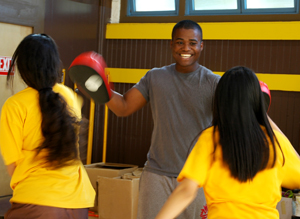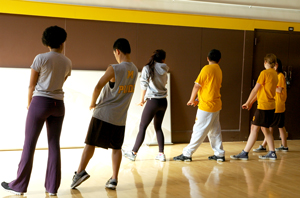Fitness club gets youth exploring diverse career options
Dec. 14, 2011 -- Muscles were warming up and the music was pumping as teenagers in the Kinesiology Career Club at Mission High School punched the air and jogged in place, gearing up for an hour of dance, martial arts and weight lifting.

Kinesiology senior Christian Ross teaches martial arts to high school students at the Kinesiology Career Club.
The club is more than a welcome alternative to second period P.E. It is an opportunity for students to work out under the guidance of SF State fitness experts while also taking time out to contemplate career plans and hopes for the future.
Associate Professor of Kinesiology David Walsh designed the club to use physical activities to help young people contemplate careers, including introducing them to jobs in kinesiology they may not have considered before. The twice-weekly meetings also help students develop confidence and leadership skills.
"If you don't come from a college-educated family, maybe you haven't had exposure to the different careers you could go into," Walsh said. "I know because that was the case in my experience."
Before the club began, many of the participants had never heard of the field of kinesiology. But a few weeks later, a dozen ninth-graders are sitting cross-legged on the gym floor, discussing the kinesiology careers that now interest them. Some want to turn their love of sports into a career as a coach or sports psychologist. Student Sarah Villareal says she wants to help others, so she's considering training as a physical therapist.
"These kinds of jobs are things that we don't think about looking into," Villareal said. "We just think that having a good career means becoming a doctor or lawyer."
During club meetings, participants rotate through four stations: dance, martial arts, weight training and fitness activities. SF State kinesiology seniors enrolled in Walsh's community-service learning class (KIN 696) lead the activities and gradually hand over more of the leadership role to the high school students week by week.

SF State student mentors and participants in the Kinesiology Career Club practice dance moves.
"This class is perfect for me because I want to become an athletic coach," said student Christian Ross, who teaches martial arts at the club. "I love helping kids and seeing their progression."
At Ross' station, participants enjoy getting rid of some energy as they punch the padded punching shields that Ross holds up. But how do you take kids from learning a new jab to tackling some of the deeper issues that the club aims to address? "It has to start with me," Ross said. "While I'm teaching, I explain to them how you can help someone else improve. I respect them and give them power to lead some of the activities."
Each meeting concludes with mentoring time when the high school students sit down with an SF State student. Using flow charts and work sheets, the mentors help the students map out how they can reach their career goals -- whether it's a kinesiology-related job or another career of their choice. The mentors provide information on college entry requirements and classes required for specific majors.
For the last 15 years, Walsh has run similar programs in underserved communities using a sports-based youth development model called Teaching Personal and Social Responsibility (TPSR). Typical TPSR programs teach life skills, such as respect and teamwork, but Walsh says his Kinesiology Career Club is the first to focus on career planning. He developed the blueprint for the club after noticing that participants in TPSR programs don't always transition well to work or college.
“Ninth grade has the biggest dropout rate," Walsh said. "It's a crucial time in kids' transition to high school, and these kids already have a lot of stuff going on in the rest of their lives -- dangerous neighborhoods and sick parents, for example. But when the kids show up each week in the gym and give it their all, they learn that they can put in that effort to other areas of their lives too. We talk with them about how the little things you do affect the big things, like career goals."
Walsh hopes the club will serve as a model program. He will share his findings from the club in two research papers that will be published next year in the Spanish journal Agora.
Read more about Walsh's urban youth development work in this SF State Magazine story.
More information about SF State's Kinesiology Department can be found at: http://kin.sfsu.edu/
-- Elaine Bible
Share this story:
